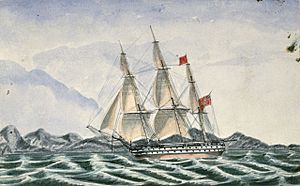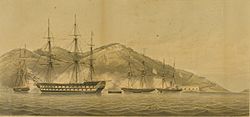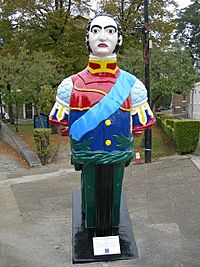HMS Wellesley (1815) facts for kids
HMS Wellesley was a powerful 74-gun warship, part of the British Royal Navy. She was named after the famous Duke of Wellington and launched in 1815. This ship played a big role in British history, helping to capture Karachi and taking part in the First Opium War. This war led to Britain gaining control of Hong Kong. Later in her life, Wellesley became a training ship. She holds a unique place in history as the last British warship of her kind to be sunk by enemy action, and the only one ever sunk by an air-raid.
class="infobox " style="float: right; clear: right; width: 315px; border-spacing: 2px; text-align: left; font-size: 90%;"
| colspan="2" style="text-align: center; font-size: 90%; line-height: 1.5em;" | 
|}
Contents
| History | |
|---|---|
| Name | HMS Wellesley |
| Namesake | Arthur Wellesley, 1st Duke of Wellington |
| Ordered | 3 September 1812 |
| Builder | Bombay Dockyard |
| Laid down | May 1813 |
| Launched | 24 February 1815 |
| Renamed | TS Cornwall, 1868 |
| Honours and awards |
China 1840–42 |
| Fate | Sunk by bombing, 24 September 1940, raised and broken up 1948 |
| General characteristics | |
| Class and type | Officially part of the Black Prince class, but built to the lines of the Vengeur class |
| Tons burthen | 1745 75⁄94 (bm) |
| Length |
|
| Beam | 47 ft 7 in (14.5 m) |
| Depth of hold | 21 ft (6.4 m) |
| Sail plan | Full-rigged ship |
| Armament |
|
Building the Wellesley
The Wellesley was meant to be a specific type of ship. However, the original building plans were lost in 1812. Because of this, she was built following the design of another ship, the HMS Cornwallis.
The ship was built in Bombay Dockyard in India. It was made from strong teak wood. The construction cost about £55,147. Wellesley was launched on February 24, 1815.
Life at Sea: Active Duty
In 1823, Wellesley sailed to Portugal and Brazil. She carried Sir Charles Stuart de Rothesay. His mission was to make a trade agreement with Pedro I of Brazil. The artist Charles Landseer joined this important journey.
In November 1824, a strong storm pushed Wellesley ashore at Portsmouth. She was later freed. From 1827 to 1830, Wellesley was the main ship, or flagship, for Rear Admiral Sir Frederick Lewis Maitland in the Mediterranean Sea.
Capturing Karachi
In 1837, Captain Thomas Maitland took command of Wellesley. The ship became the flagship for Rear-Admiral Frederick Lewis Maitland.
On February 2 and 3, 1839, Wellesley and another ship, HMS Algerine, helped capture Kurrachee. Today, this city is known as Karachi in Pakistan. Wellesley sailed into the harbor and fired at the mud fort on Manora Island. The fort was quickly destroyed. This attack was to make local leaders sign a new agreement with the East India Company.
The Anglo-Persian Treaty
In March 1839, there was tension between Persia and Britain. Britain wanted a permanent base on Kharg Island. Attacks on the British office in Bushire led to Wellesley and Algerine being sent there.
This situation ended with the Anglo-Persian Treaty. It was signed on October 28, 1841. The treaty allowed both sides to trade freely. It also let the British set up offices in Tehran and Tabriz. Admiral Maitland sadly died on board Wellesley in November. Commodore Sir James Bremer took his place.
The First Opium War
Wellesley played a major part in the First Opium War in the Far East. In July 1840, led by Commodore James Bremer, British forces captured Chusan. This happened after a brief fight with shore defenses. When Wellesley returned, 27 cannonballs were found stuck in her sides.

On January 7, 1841, she helped in the Second Battle of Chuenpi. She also bombarded forts at Tycocktow. These forts guarded the way to Canton. This campaign led to Britain taking Hong Kong Island on February 26, 1841.
On the same day, Wellesley fought in the Battle of the Bogue. This battle involved attacking and destroying almost all Chinese forts. These forts were on both sides of the Bocca Tigris, leading up to Canton. The next day, sailors and Royal Marines attacked and captured a Chinese position. This was during the Battle of First Bar.
Between May 23 and 30, Wellesley helped capture Canton. The Chinese then had to pay a large sum of money. Rear-Admiral Sir William Parker became the new commander of the British squadron in China.
On August 26, Wellesley helped destroy defenses around Amoy. Captain Maitland bravely placed Wellesley very close to the main fort. The British temporarily took over Amoy and its key defenses. Later, on October 1, the British reoccupied Chusan and the city of Tinghae. The British went on to capture Amoy, Ningpo, Woosung, and Shanghai. The war ended when they took Chinkiang and blocked the entrance to the Grand Canal in July 1842.
Captain Maitland was honored for his service during the war. He was made a Companion of the Bath and was knighted in 1843. Many of Wellesley's crew received the China Medal.
Training and Harbour Service
In 1854, Wellesley became a guard ship at Chatham. She then served as a main ship and a place for new sailors to join.
In 1868, the Royal Navy loaned her to the London School Ship Society. She was turned into a Reformatory School for boys. She was renamed Cornwall and was anchored near Purfleet. Later, the ship, renamed Wellesley again, moved to the River Tyne. There, she became The Tyne Industrial Training Ship of Wellesley Nautical School. The famous actress Lena Ashwell was born on board in 1872.
On August 10, 1887, another ship, the Aviemore, crashed into Wellesley. This caused serious damage to her back end. In 1928, because of new buildings in the area, she was moved to Denton, near Gravesend.
The Final Loss
On September 24, 1940, during World War II, German planes attacked Wellesley. She was badly damaged and sank. This made her the last British ship of the line to be sunk by enemy action, and the only one ever sunk by an air-raid.
In 1948, the ship was raised from the water. She was then taken to Tilbury and taken apart. Some of her wood was used to rebuild the Royal Courts of Justice in London. Her figurehead, which is the decorative carving at the front of the ship, can now be seen at the main gates of Chatham Dockyard.
Images for kids



